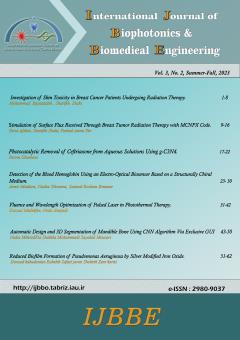Investigation of skin toxicity in breast cancer patients undergoing radiation therapy
محورهای موضوعی : Biomedical Spectroscopy, Microscopy, Imaging, EndoscopyMohammad Bayatzadeh 1 , Sharifeh Shahi 2
1 - Department of Biomedical Engineering, Islamic Azad University of Isfahan (Khorasgan) branch, Isfahan, Iran.
2 - Laser and Biophotonics in Biotechnologies Research Center, Islamic Azad University of Isfahan (Khorasgan) branch, Isfahan, Iran.
کلید واژه: breast cancer, Conventional, radiation therapy, Hypo fractionation, Skin toxicity,
چکیده مقاله :
This study investigated skin toxicity in breast cancer patients undergoing radiation therapy. The study was conducted in 1401 at a radiation therapy center in Yazd city and included 30 patients who underwent radiation therapy using conventional and hypofractionation methods, and in which the whole or part of the breast was exposed to radiation. Skin complications of grade skin toxicity during treatment and within 40 days after radiotherapy were evaluated in both methods. Results showed that the four people (26.6%) had grade three and the six people (40.0%) had grade two skin toxicity, with conventional treatment causing more skin complications compared to hypofractionation, which caused fewer skin complications without reducing efficacy. Additionally, the ratio of skin complications in the conventional technique was higher than in the hypofractionation technique after 40 days of radiation therapy. The study concluded that hypofractionation results in fewer skin complications than conventional treatment.
[1] N. Hamzian, M. Shabani, K. Saber, and F. Madadizadeh, "Evaluation of Safety Measures and Related Factors in Yazd Radiation Therapy Center in the Face of Covid-19 in 2020," Journal of Shahid Sadoughi University of Medical Sciences, vol. 31, pp. 1-10, 2023.
[2] G.P. Delaney and M.B. Barton, "Evidence-based estimates of the demand for radiotherapy," Clinical Oncology, vol. 27, pp. 70-76, 2015.
[3] S.A. Bhide and C.M. Nutting, "Recent advances in radiotherapy," BMC medicine, vol. 8, pp. 1-5, 2010.
[4] K. Saber, N. Hamzian, and F. Madadizadeh, "COVID-19 Anxiety and Related Factors in Cancer Patients Undergoing External Radiation Therapy," Asian Pacific Journal of Cancer Care, vol. 7, pp. 451-458, 2022.
[5] E. Senkus-Konefka and J. Jassem, "Complications of breast-cancer radiotherapy," Clinical Oncology, vol. 18, pp. 229-235, 2006.
[6] M. Okamura, S. Yamawaki, T. Akechi, K. Taniguchi, and Y. Uchitomi, "Psychiatric disorders following first breast cancer recurrence: prevalence, associated factors and relationship to quality of life," Japanese Journal of Clinical Oncology, vol. 35, pp. 302-309, 2005.
[7] C. Jd , "Toxicity criteria of the radiation therapy oncology group (RTOG) and the European organization for research and treatment of cancer (EORTC)," Int. J. Radiat. Oncol. Biol. Phys. vol. 31, pp. 1341-1346, 1995.
[8] B. V. Offersen, L. J. Boersma, C. Kirkove, S. Hol, M. C. Aznar, A. Biete Sola, Y. M. Kirova, J.-Ph. Pignol, V. Remouchamps, K. Verhoeven, C. Weltens, M. Arenas, D. Gabrys, N. Kopek, M. Krause, D. Lundstedt, T. Marinko, A. Montero, J. Yarnold, and Ph. Poortmans, "ESTRO consensus guideline on target volume delineation for elective radiation therapy of early stage breast cancer," Radiotherapy and oncology, vol.114.1, pp. 3-10, 2015.
[9] J. Yarnold, S.M. Bentzen, C. Coles, and J. Haviland, "Hypofractionated whole-breast radiotherapy for women with early breast cancer: myths and realities," International journal of radiation oncology, biology, physics, vol. 79, pp. 1-9, 2011.
[10] N. Hamzian, M. Shabani, K. Saber, and F. Madadizadeh, "Evaluation of dose–response models and parameters predicting radiation induced pneumonitis using clinical data from breast cancer radiotherapy," Physics in Medicine & Biology, vol. 50, pp. 3535 (1-10), 2005.
[11] J. Arsenault, S. Parpia, M. Goldberg, E. Rakovitch, H. Reiter, M. Doherty, H. Lukka, J. Sussman, J. Wright, J. Julian, and T. Whelan, "Acute toxicity and quality of life of hypofractionated radiation therapy for breast cancer," Int J Radiat Oncol Biol Phys. vol. 107, pp. 943-948, 2020.
[12] L. Christopher Schmeel, D. Koch, F. Carsten Schmeel, F. Röhner, F. Schoroth, B. Maja Bücheler, B. Mahlmann, Ch. Leitzen, H. Schüller, S. Tschirner, A. Fuhrmann, M. Heimann, D. Brüser, A.-V. Abramian, Th. Müdder, S. Garbe, S. Vornholt, H. Heinz Schild, B. Gertrud Baumert, and T. M. Wilhelm-Buchstab, "Acute radiation-induced skin toxicity in hypofractionated vs. conventional whole-breast irradiation: An objective, randomized multicenter assessment using spectrophotometry," Radiotherapy and Oncology, vol. 146, pp. 172-179, 2020.
[13] R. Jagsi, K. A Griffith, Th. P Boike, E. Walker, T. Nurushev, I. S Grills, J. M Moran, M. Feng, J. Hayman, and L. J Pierce, "Differences in the acute toxic effects of breast radiotherapy by fractionation schedule: comparative analysis of physician-assessed and patient-reported outcomes in a large multicenter cohort," JAMA oncology, vol. 1, pp. 918-930, 2015.
[14] H.L. Hou, Y.C. Song, R.Y. Li, L. Zhu, L.J. Zhao, Z.Y. Yuan, J.Q. You, Z.J. Chen, and P. Wang, "Similar outcomes of standard radiotherapy and hypofractionated radiotherapy following breast-conserving surgery," Med Sci Monit. vol. 21, pp. 2251–2256, 2015.
[15] T.Y. Chan, J.I. Tang, P.W. Tan, and N. Roberts, "Dosimetric evaluation and systematic review of radiation therapy techniques for early stage node-negative breast cancer treatment," Cancer Management and Research, vol. 10, pp. 4853-4870, 2018.
[16] L. Gu, W. Dai, R. Fu, H. Lu, J .Shen, Y. Shi, M. Zhang, K. Jiang, and F. Wu, "Comparing hypofractionated with conventional fractionated radiotherapy after breast-conserving surgery for early breast cancer: a meta-analysis of randomized controlled trials," Frontiers in Oncology, vol. 11, pp. 753209 (1-12), 2021.


